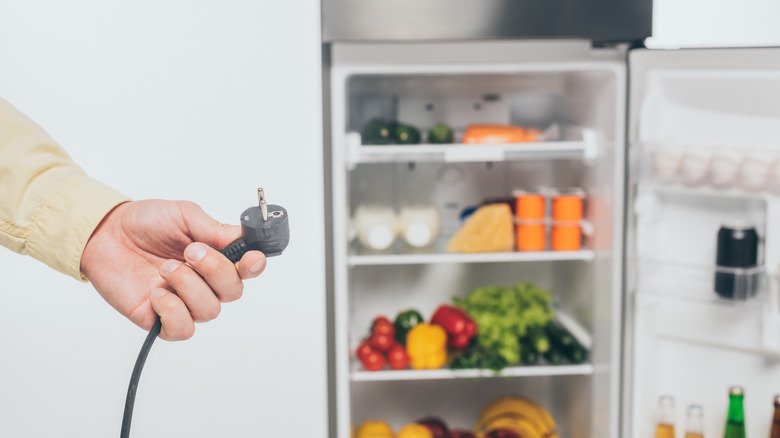Don't Skip One Important Step When Buying A New Fridge
Imagine going through the steps of choosing the right refrigerator for your kitchen, from measuring your space and shopping models to finalizing a purchase and bringing it home, only for it to break down immediately. A nightmare for any homeowner, it's also a common reality for consumers, and not because they're buying duds. The issue: Laying the fridge on its side in transit.
When you lay a fridge flat, all the liquids that make it work move out of place, potentially resulting in catastrophe when you plug it in. Considering the time and money you put into purchasing it, having your new fridge fail right out of the gate can be truly heartbreaking. Fortunately, this is one of those mistakes everyone makes when buying their refrigerator, and it's often easy to overcome, as long as you don't skip the crucial step of waiting to start using your new appliance.
The conventional wisdom is that fridges should stand upright for 24 hours after lying down. That way, everything can settle into place before it has to start working. While refrigerators vary in how long they should sit before operating, waiting a day is a safe measure regardless of the unit's age, style, or brand. If you want to use your fridge sooner, though, a few careful considerations could get it up and running within a few hours.
What happens when you lay a fridge on its side?
The compressor is the heart of the refrigerator's cooling system. It serves the vital function of compressing the refrigerant to give it more heat to expel at the condenser, and it also pumps the refrigerant along its cooling and heat-release circuit. When it fails, the whole system comes to a halt. Tilting the fridge or laying it on its side allows the compressor's oil, which usually sits at the bottom of the tank, to flow where it shouldn't, namely to the coolant line. Add in the shaking and jostling from bumps in the road, and the trip to your home can promote significant oil drainage as your fridge lies down. Should you plug it in too soon and make the compressor start working, this could cause a severe breakdown in one of the most expensive appliance parts to replace in the home.
So, how do these problems happen? When viscous compressor oil gets into the line that typically only contains gaseous coolant, blockages can occur. Refrigerant will no longer flow smoothly along its track to keep the temperature down. Capillary tubes, filters, and other delicate components not meant to handle oil will bind up and degrade. Since the compressor can't compress liquids like oil, it will struggle to operate and wear out quickly. The compressor also won't have the lubrication it needs to run efficiently, increasing the possibility that it will seize up and break down.
How long should you let your fridge stand up before plugging it in?
Knowing the issues that come with oil entering the lines, it's crucial to let your fridge sit long enough for gravity to pull it back into the compressor. Older refrigerators usually need to sit for about 24 hours, no matter how long they were on their side. Newer models are a different story. Changes to coolant, oil types, and seals have lessened the time it takes for the liquids to flow back to where they should be. Some manufacturers direct consumers to leave the fridge standing for just a few hours or for as long as it was lying down. For instance, if your fridge lies down for an hour, you should only have to let it stand for an hour before plugging it in.
There are a few ways to reduce the impact of laying your fridge down as well. One tip is to check where the copper discharge and suction lines enter the compressor. By laying the fridge on the opposite side so the compressor sits under these lines, the oil can't flow into them. If you can limit how much you tilt your fridge, that's even better. More importantly, you should check your manufacturer's guidelines. Every brand has different recommendations for standing their units upright, and they can vary based on the model. By checking the manufacturer's instructions before laying your fridge down, you'll minimize the chances of issues — or any hiccups with a warranty claim if your refrigerator fails.


